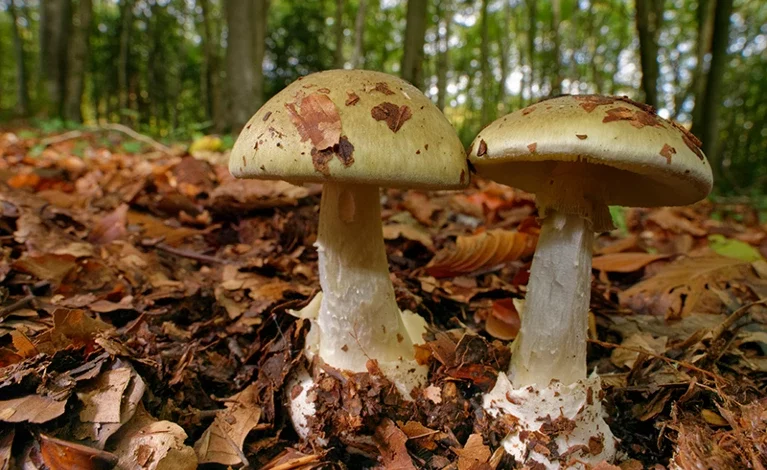Deadly mushroom poison might now have an antidote with help from CRISPR

The death cap mushroom (Amanita phalloides), which has been the ‘killer of kings’ for centuries, could be losing its edge. Scientists have found a possible antidote for the deadly mushroom’s toxin.
Growing up to 15 centimetres high, with unassuming tan or yellow-green tops, death caps can taste quite nice, according to people who have accidentally eaten them and survived. But afterwards, the toxin can cause vomiting, seizures, severe liver damage and death. The Roman Emperor Claudius is thought to have died from consuming the mushrooms in AD 54, and so is the Holy Roman Emperor Charles VI, in 1740. Today, hundreds of people die from eating poisonous mushrooms each year, and death caps are responsible for 90% of those fatalities.
Despite their deadly reputation, death caps have kept scientists guessing as to how they kill. But when researchers recently identified a potential antidote, they also zeroed in on the biochemical pathway in humans that’s necessary for the mushrooms’ toxin — called α-amanitin to enter cells. The antidote, a chemical named indocyanine green, interrupts that pathway. The team reported these findings in Nature Communications on 16 May.
“That’s fantastic,” says Helge Bode, a natural product chemist at the Max Planck Institute for Terrestrial Microbiology in Marburg, Germany. “α-Amanitin really is one of the most dangerous compounds that we have in nature.”
A ‘very modern’ approach
Despite death caps’ long history of poisoning people, physicians have little to offer people who accidentally ingest them, besides supportive care. The area seemed ripe for research, so Qiaoping Wang and Guohui Wan, both drug-development researchers at Sun Yat-sen University in Guangzhou, China, decided to dive in.
The scientists used a method that Wang and others developed a few years ago2 to find an antidote for jellyfish venom. They first used CRISPR-Cas9 gene-editing technology to create a pool of human cells, each with a mutation in a different gene. They then tested which mutations helped the cells to survive exposure to α-amanitin.
This ‘CRISPR-Cas9 screen’ revealed that cells lacking a functional version of an enzyme called STT3B are able to survive α-amanitin. STT3B is part of a biochemical pathway that adds sugar molecules to proteins. Interrupting this pathway somehow blocks α-amanitin from entering cells, preventing the toxin from fully wreaking havoc. Nobody had any idea that STT3B played a part in α-amanitin toxicity, and “we are totally surprised by our findings”, Wang says. The researchers intend to continue investigating how the pathway involving STT3B normally lets α-amanitin inside cells.
The second step in the researchers’ strategy had them sifting through about 3,200 chemical compounds, looking for one that would block the action of STT3B. Among those compounds, they uncovered indocyanine green, a dye developed by the photography company Kodak in the 1950s that has since been used in medical imaging, for example, to visualize blood vessels in the eye and blood flow in the liver. Only about 50% of mice treated with indocyanine green died from α-amanitin poisoning, compared with 90% of those that were not treated.
Researchers are excited about this method for finding antidotes, which is “very modern”, says toxicologist Jiří Patočka at the University of Southern Bohemia in České Budějovice, in the Czech Republic. Bode thinks similar experiments could identify antidotes for bacterial toxins that cause sepsis, which is currently difficult to treat.
Moving to the clinic
The US Food and Drug Administration and the European Medicines Agency have already approved indocyanine green for use in imaging. The chemical is known to be safe at certain dosages, so Wang and Wan hope that they can soon begin testing it in people, although finding funding might be challenging, and tests will need to rely on people who accidentally ingest death caps. Timing will be key in these studies, said toxicologist Félix Carvalho from the University of Porto in Portugal. The researchers treated mice with indocyanine green starting four hours after the animals were exposed to α-amanitin, but most people who eat death caps don’t show up at hospital for 24 to 48 hours, after it’s clear that their condition is serious. “It may be too late by then,” Carvalho says.
Researchers are nonetheless excited about the medical advances that this method could bring. “There should be more scientific studies like this,” Patočka says.
doi: https://doi.org/10.1038/d41586-023-01630-9